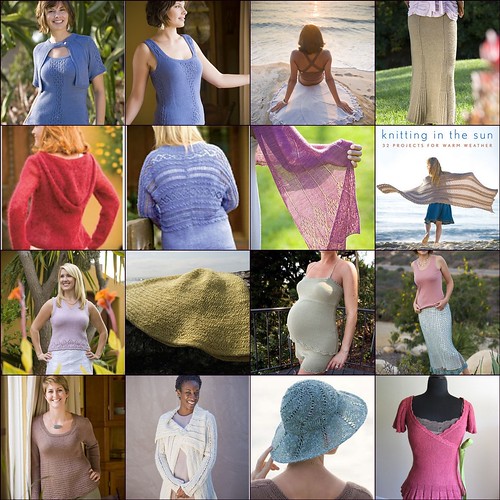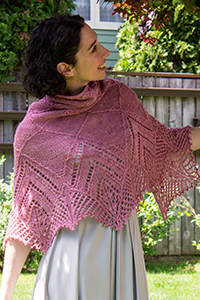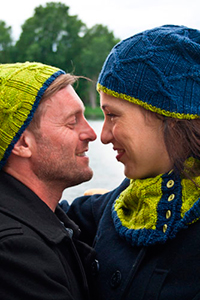I lived most of my life in New Hampshire and Massachusetts, experiencing the full range of seasonal changes from hot and muggy to sub zero, covered in ice, I think my eyes just froze shut cold. But it wasn't until I moved to Los Angeles that I suddenly rediscovered knitting and took to it in earnest. Five years in a climate that rarely dips below 55 degrees Fahrenheit and often blasts right past 90, gave me a keen appreciation for versatile and light knits. As any of you living in warmer climates know, balancing comfort in the hottest temperatures with the over zealous application of climate control in various offices, restaurants, theaters and stores, is not as easy as one might assume.
Enter Kristi Porter's newest book, Knitting In The Sun. This collection of 32 projects is sure to please almost anyone who lives somewhere with at least a few months of warm weather.
For my stop on Kristi's blog tour, I'm doing a brief interview with several of the contributing designers from the book. A huge thank you to the following designers for their contribution (in alphabetical order).
- Carol Feller [CF]
- Faina Goberstein [FG]
- Anne Kuo Lukito [AKL]
- Janine Le Cras [JLC]
- Kristi Porter [KP]
- Julia Trice [JT]
I think you'll all agree that their answers are really interesting and their designs are simply lovely.

1. Quimper, 2. Anna Maria Tank, 3. Cinnamon Bay, 4. Blacksea, 5. Alishan, 6. Yehliu, 7. Bordeaux, 8. Cover, 9. Provence, 10. Bardini, 11. Vernazza, 12. Cabrillo, 13. Puget Sound, 14. Coronado, 15. Windansea, 16. Aviara
Ravelry Link to the projects in this book here
Most images Copyright Wiley Publication, all rights reserved. One image copyright Julia Trice, all rights reserved.
Q: What piece(s) did you design in the book and give a brief description
[CF]: I designed 3 pieces for this book. The first was "Anna Maria Tank" which is a lightweight bamboo tank with an hourglass motif traveling up the front, back and sides of the piece. The second design was "Quimper Bolero" which was a matching piece to be used with the tank. Also from bamboo and knitted from the top down with the hourglass motif growing down from the top of the sleeve. The final piece designed for the book was "Cinnamon Bay" which is a knitted bag which converts to a beach blanket when the I-cord tie is fully opened.
[FG]: Marnie, let me start with saying thank you for inviting me to your blog. It is great to talk to you again. I am very excited that my new design Black Sea is included in this book. I love how the book came out. Black Sea is a skirt that is knit in the round with six panels which are separated by faux seams with the triangular design for a little bit of a flair at the bottom.
[AKL]: I have 2 pieces in the book:
ALISHAN - A hoodie pullover worked on lace weight yarn on larger needles, with part of it worked double-stranded to play with the contrast of lightness and opaqueness. I talked a bit about the pattern from the process to the naming of it in two recent posts here and here.
YEHLIU - A luscious kimono-style cardigan knit in a wool/silk yarn. It is knit side-to-side with a lace and cables detail at the top, assembled, and then stitches are picked up to work the rest of the body. I haven't posted detailed information about Yehliu yet, but have plans to discuss it in the same detail that I discussed Alishan on my blog.[JLC]: I designed the Provence tank which is a lovely v-necked tank with a lace trim at the hem and Bordeaux which is a laceweight stole
[KP]: I designed four pieces for the book: a sun hat called Windansea, a fishnet skirt called Cabrillo, Puget Sound, which is an easy going scoopneck pullover, and a wrap-style cardigan with a broad collar called Coronado.
[JT]: I designed a sleep set in a wonderful cotton bamboo blend yarn, and co-designed (with you!) a sun cloche in a crisp linen. The sleep set has touches of lace at the edges, but is not frilly. It has clean lines with light feminine detailing. The cloche utilizes a herringbone stitch that makes it look woven rather than knitted. The Euroflax linen yarn that I designed it in gives it a sunny straw hat look, which makes it even more appropriate as beach wear.
Q: How do you feel your piece(s) address(es) the needs of warm weather knitters? What sorts of thoughts went into choosing the yarn, shape, concept etc?
[CF]: Although I live in Ireland I spent several years living in Florida so was aware of the particular difficulties of living (and knitting) in warmer weather. The bamboo used for the tank/bolero set seems like an ideal warm weather fiber. It is naturally anti-bacterial and odour resistant which for humid weather would be a useful feature. I also love the idea of matching sets for warmer weather. In the States air conditioning tends to be set fairly low so by having a matching bolero you can still keep the feel and aesthetic of your outfit without freezing every time you need to go indoors.
[FG]: We, knitters, do not stop to knit because of the weather. We adapt. When I was choosing the yarn for this skirt I was considering a few factors: keeping the shape of a skirt, the comfort of wearer, the neutral color that goes well with many tops, and no less important issue of knitting with this yarn when it is warm or even hot outside. Linen Jeans by Berroco seems to meet all these requirements. I loved to knit with it and I am happy with the result.
[AKL]: For both garments, I was thinking about the cool California mornings and evenings, especially along the coast. In northern California, where I lived for several years, you sometimes do have to wear long sleeves all day, even in summer, and especially once the sun goes down. In southern California, it's certainly not quite as cold as San Francisco, and it can get darned hot out here, but early mornings and evenings still get nippy. So, I envisioned something that can serve as a nice, light, relaxed and comfy cover-up for those cooler evenings or mornings. Even though both garments are long-sleeved, the openness of Alishan and the lacy details of Yehliu make the garments more appropriate for warmer weather, and they can also serve as good transitional pieces in Spring, Fall or even Winter for those living in areas way hotter than California weather, such as my friends in Texas.
[JLC]: With the tank I purposely went for a yarn that would breathe. I chose Rowan Calmer because it also has a small amount of microfibre in it's content which will help the garment to keep it's shape.
With Bordeaux I was aiming for a light and lacy stole that could be easily shoved into your purse for an extra layer when the wind was chilly or the air conditioning was a bit too cold. The Lorna's Laces Helens Lace fit the bill perfectly giving the finished piece a light and airy feel with that little bit of luxury - 50% silk.[KP]: To take Puget Sound as an example of thinking through a design appropriate for warmer weather, a long-sleeved pullover isn't maybe at the top of one's mind, but I think of it as a great sweat-shirt alternative. It's easy to throw on in the morning or evenings when things get cool, and it's definitely something I'd wear year round. Elongated stitches formed by making extra wraps and dropping them mean the lower arms and torso let plenty of air flow through and keep the garment lightweight. The scoopneck is easy to wear and flattering. I chose Cascade Venezia Worsted for the project. It's a silk/wool blend with a cottony feel. It's got a great combination of structure and drape and is definitely something you can wear next to your skin, so you don't have to wear too much under it.
[JT]: With both the cloche and the sleep set I was aiming for something a little different, but not so different as to be inaccessible. Warm weather knits usually include short sleeves and tanks. I love those kinds of knits, and they necessarily form the backbone of warm weather knitting, but I wanted to expand summer knitting horizons a bit. I think summer knitting can feel limited, so my goal was to try to design things that would make knitters think outside the box a little with their warm weather knitting and hopefully be inspired. I had recently worked with Classic Elite’s Cotton Bam Boo, which I used for the sleep set, and really loved its soft, cool hand. It made the kind of fabric that you could slip into and drift off to sleep in, but was also sexy and slinky if you didn’t want to drift off too soon. :) For the sun hat, Euroflax was a no-brainer for me. It creates a good structure without being too stiff, it is light and breathable and undeniably summery.
Q: Did you design your knit(s) with yourself in mind or a particular type of knitter or need?
[CF]: When I am designing I find myself balancing between a flattering piece to wear and an enjoyable and interesting knit. I think that most of what I design starts with me imagining something I would like to wear myself, otherwise why would anyone else want to? From there I try to put it together in a way that makes to most sense as a knitter.
[FG]: Good question. The name I gave to this skirt is Black Sea. You could say that I designed it with memories about the resort spots on the shores of this beautiful sea. I had in mind a woman strolling in the park or along the embankment in this cool and comfortable skirt. This project is great for a knitter who likes or wants to learn how to knit in the round.
[AKL]: Most of the time, when I design, I design with things that I might wear, or things that my sister or my friends would wear.
[JLC]: Being on the larger side I try to remember that not all of us can wear skimpy cropped tops and design accordingly :-)
I usually finish up designing something that I know I would wear and thankfully so far it seems others like it too! :-)[KP]: I think I always design for myself on some level, but I am very aware of the needs and desires of knitters and I try to be mindful of creating things that will work for a broad range of body types and sensibilities. Since I teach knitting regularly, I get feedback from my students about what works for them and what doesn't. And often, one of them will come to me with an idea for something they want to knit and a design will come out of the conversations we have about it.
[JT]: I started with myself for both pieces. I went through a short phase right after I began designing for publication where I tried to anticipate what would appeal to a wide array of people, and I utterly failed. With my own designs it is often hard for me to predict what will strike a note with others. Pieces ring true when I put my heart into them and that is easier to do when I start with myself or a loved one as the wearer.
Q: How do you envision using your piece once it's returned to you? Do you have everyday pieces? Or are your pieces more appropriate for special occasions?
[CF]: I don't think I will ever see "Cinnamon Bay" when it returns to the house. My 4 boys all love blankets and bags and I'm fairly sure one of them will get their hands on it first.
We get so little warm weather in Ireland that "Anna Maria Tank" will probably end up being primarily for holiday use. "Quimper bolero" will see a little more use here as I really like wearing a plain t-shirt with a shrug/bolero over it to change it into an outfit with a bit more style and individuality.
[FG]: Since the design of this skirt is very versatile, it can be worn as an everyday piece or an addition to the evening outfit with a dressy top.
[AKL]: Ah, unfortunately, due to my sensitive skin and recent horrid allergies (this was explained in my first detailed blog post about Alishan), I don't think I will be wearing the Alishan sample though I designed it with myself in mind. When we actually get the physical store up and running (lets see if the economy will cooperate), I'll be displaying Alishan as a store sample. If I have the time, I really would like to make myself one out of something luscious, like a really nice silk or merino lace yarn.
For Yehliu, I think I will also display it as a store sample for a little while, then I may give it away to my godmother, since I think it will be a garment that she will certainly covet. She and my godfather really love showing people the beauty (and good eats) of Taiwan, so I really think that she'd enjoy the fact that I named the garment after such a beautiful place.[JLC]: I often wear tanks to work with either a shirt or a jacket over the top - so I can see Provence getting a lot of use. I also have oodles of scarves, stoles and shawls that I wear all the time - so I can see Bordeaux finding its way into my wardrobe too!
[KP]: I tend to design "everyday" knits. I want them to be something you reach for again and again. As a knitter, I do enjoy complex or quirky patterns and have knit things that, in my heart of hearts, I knew I wouldn't really have much occasion to wear just because the process of knitting them was appealing. But realistically, I want the garments I knit and design to be things that I can wear without having to plan a whole outfit or outing around.
[JT]: The cloche is definitely for every day, and it will absolutely accompany me to the beach, which is where I wear summer hats. The sleep set will probably be seen as more of a special occasion knit for many knitters, but I anticipate getting a lot of use out if it as well. The shorts are especially easy to toss on and I may make myself a second pair of them before the sample comes back. They are comfy and sexy, which is a perfect combination in my book.
Q: Do you have any recommendations for adapting your piece(s) for cooler weather for those who don't have the luxury of living somewhere warm?
[CF]: The tank and bolero combination would work very well if a warmer material was used, and possibly extending the body and arms of the bolero a little to give more warmth. Tanks used under shirts or jackets can really be used in any weather with good effect.
Cinnamon Bay can easily be used in any climate as a bag/blanket. It would also be wonderful for use as a baby blanket and to store toys.[FG]: It can definitely be knitted using wool or wool blends. This will make the skirt warm enough for cooler weather. I just want to remind our readers to check the gauge even when the same yarn is used.
[AKL]: Unless you are an exhibitionist, I certainly don't recommend wearing either of my pieces without any other clothing item underneath in any weather. For cooler weather, I think that a silk/alpaca blend (higher silk content than alpaca) yarn can be substituted for Alishan, but I really would suggest that the alpaca content NOT be too high (unless you pre-plan, swatch, swatch, swatch, and then adjust accordingly), because of the drapiness of alpaca, the garment can sag and grow more than you want to.
[JLC]: Well I often wear tanks layered either under or over a shirt and stoles an be worn in any weather ( at least that's my motto)
[KP]: Most of the knits in the book are suitable for all climates at least part of the year. The idea of layering was definitely in mind as I selected patterns for the book. If you wear a turtleneck instead of a tank top under the pullovers or cardigans, you'll definitely be able to wear them year round. Likewise, pairing some of the sleeveless or short-sleeved tops with a jacket will give you more opportunities to wear them.
[JT]: I think the cloche would be wonderful re-worked in a thick, dark wool, and perhaps even felted for a slightly different texture. This would take some re-working of the numbers, but if you look at the pattern you'll see that it isn't too hard to re-gauge. For the sleep set my best suggestion is to make it as is and then slip under the comforter with your significant other. Things will heat up. :)
Q: Were there any techniques, shapes, materials, or other factors that were new to you and did you discover anything interesting in the process?
[CF]: I hadn't worked with bamboo yarn before this book and I discovered that it is quite different to animal fiber. When I knitted the swatch and washed it I discovered how much bamboo can stretch! To take account of this I have both the pre and post blocking gauges given in the book and the tank is designed to be knit with negative ease to compensate. For anyone who is knitting this piece I would strongly suggest washing their swatch and using that as their guide for knitting gauge.
[FG]: Instead of decreasing stitches, I changed needle sizes as I worked from the bottom up on this skirt. This could be new and unusual to some people. I used this technique for two skirts in the book Casual, Elegant Knits that I co-authored with Dawn Leeseman.
[AKL]: I really loved working on both garments for different reasons. However, if I had to pick one over the other, despite the horrid allergies that thwarted my progress, I really liked designing Alishan more because I really was excited to create the contrast between lightness and opacity in the design with the variance on single and double stranding.
[JLC]: I discovered that to graft laceweight together you need the patience of Job - apart from that everything was straightforward.
[KP]: I learned a lot from working with the designers who contributed to Knitting in the Sun. I think that's one of the joys of being involved in a book with many contributors. Each brought their own design sensibility and aesthetics to their patterns which makes the book much richer. Working as closely as I have with these patterns over the last year has given me a chance to really understand what makes them tick and how each designer solved the inevitable riddles of shaping and construction.
[JT]: There is a horizontal braid that runs underneath the bustline of the sleep set that I picked up from June Hiatt’s Principles of Knitting. It took me a few tries to get the hang of it, but I love the effect and will definitely use it again. The little herringbone pattern for the cloche was also new to me. It was interesting to learn and a good stitch to have in my arsenal.
Q: Are there any other pieces in the book that you are looking forward to knitting, yourself?
Thanks to each of you. I think I might have enjoyed reading your answers more than anyone else will. Next up on the Knitting in the Sun blog tour is Anne Kuo Lukito. Please visit her blog in the next few days to see what she has in store for you.[CF]: I love the details in "Aviara" and I think that the knitted hat "Windandsea" looks just beautiful. Now all I need is a few extra hours in the day for more knitting time!
[FG]: Oh, there are many. Your Aviara is lovely, some shawls, some other tops, hats. I am sure when I will show this book to my family, I will get some requests.
It was great talking to you, Marnie. Congratulations on your many beautiful designs and I will look forward to seeing more.[AKL]: I'm afraid to look too much at all the wonderful designs in the book! I have a long knitting to-do list (am trying to catch up one some knitting for my sis and for charity) and plan on trying my hand on doing more designs and design submissions, so I am trying very hard to be strict with myself about not doing anything personal for the time being. Although....I really haven't made anything for myself to enjoy personally in a long time.
[JLC]: I'm still waiting for my copy of the book to get to me but I must admit from what I have seen on Ravelry there are a few I would love to knit I love Black sea, Vernazza and I could see me in the tank and matching shrug Quimper. - Actually I could see myself knitting most of the patterns in the book - so many patterns so little time....
[JT]: Yes! I just got my copy today, so I haven't had as much time to look at it as I would like, but there are many pieces that I really love. I think the piece I am most likely to make is Coronado, the openwork cardigan that Kristi designed. It's just my style. There are a lot of beautiful and clever pieces to choose from. Anacapa, the wrap on the cover, is gorgeous; Cinnamon Bay, the circular "blanket" that turns into a beach bag is smart and versatile; and Haleakala, the knitted beach chair, is brilliant. Honestly, there are so many things that I like that it pains me to have to choose just a few to mention. I am lucky to have my designs included in a book so chock full of wonderful pieces.



Living in SoCal myself, it's good to know that one's knitted pieces can also be used in various ways.
Thanks so much for interviewing all these designers, Marnie (myself included!). Like you, I love to read what other designers think and how their processes work. It's fascinating and really brings everything to life.
Great post Marnie. I really enjoyed reading the other designers' responses. Thanks for including me in your interview.
This is one of the loveliest books of lighter items that I've seen. Even though I live in the frozen north, I love wearing lighter items. Even nicer is that they pack more easily for all the travel I do. Thank you for pulling together all the designer insights.
Marnie, thank you for this interesting post. It feels that we all know each other and chatting together. Well done as usually.
I'm surprised by how many of them said they used a wool blend. I live in central Florida and clothing with any amount of wool in it sees very limited use here. I've been looking forward to this book exactly because I am so tired of having to figure out a substitute yarn and whether it will behave right. I'm still excited about it, and I heard a lot of non-wool options there. It just surprised me.